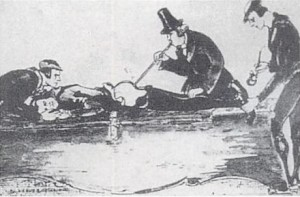 March 1934. The groan of creaking wood fills Dr. Robert Cornish’s laboratory as the rocking teeterboard strains under Lazarus’ dead weight. Rocking provides a crude form a circulation—a weak substitute for Lazarus’ heart, which has stopped beating.1
March 1934. The groan of creaking wood fills Dr. Robert Cornish’s laboratory as the rocking teeterboard strains under Lazarus’ dead weight. Rocking provides a crude form a circulation—a weak substitute for Lazarus’ heart, which has stopped beating.1
With an urgency more commonly found among the living, the Berkeley-based doctor plunges a brew of adrenaline, liver extract, gum arabic, and blood into the corpse’s thigh.1 He then puffs bursts of oxygen into Lazarus’ gaping mouth as the rocking board slowly draws the solution up and down the body.1
A leg twitch—a gasp—an unmistakable heartbeat.1
The wooden teeterboard, typically used to launch circus acrobats to death-defying heights, is being employed by Cornish to raise something far more dangerous—the dead.
Raising the dead is one of mad science’s most secretly cherished goals. Imagine a wondrous world where Dick Clark’s New Year’s Rockin’ Eve continued to be hosted by Dick Clark—where you could be served at a TGI Fridays by zombie Einstein—or have your groceries bagged by zombie Abraham Lincoln.
Problem was Cornish had no idea where to start. CPR didn’t come about until the 1950s.2 Before then even the most basic resuscitation methods had this old-wivey quality. Common guidelines for reviving a drowned person back in the day included:
- Rolling the victim over a barrel on their back.2
- Using a bellows to pump air into their mouth [and presumably right out their nose]. 2
- Siphoning tobacco smoke up the victim’s bum. 2
If reviving an unconscious drowning victim seems ludicrous with these methods, imagine using them to bring back the dead. Robert Cornish tried virtually every reanimation method known to man,3 at one point even jiu-jitsuing a dead sheep,3 without producing so much as a single zombie—or even your basic C.H.U.D.
By the mid 1930s, Cornish finally hit on a winning combination: A rocking teeterboard, adrenaline-based injections, and Fox Terriers.3 Sweet, trusting, Fox Terriers, as opposed to humans, gave him control over both the means of death, and the timing. In 1934, Cornish was able to resuscitate a dead dog, Lazarus IV, 5-minutes after its heart had stopped.4 Dogs that stayed dead for longer didn’t fare so well (see Lazaruses I-III).1,5,6
But for some reason, the public found the idea of killing/zombifying Fox Terriers oddly repellant. After much bad press, Cornish was ousted from his UCLA laboratory and forced to conduct studies in a more suitable mad-science locale, his home.6
The young doctor needed some way to convince people that his research was not only humane, but vital. This improbable wish was granted in the form of Life Returns7, a Universal horror flick that seemingly exists only to advertise Robert Cornish and his research.
In the film, John Kendrick (Onslow Stephens) is a doctor obsessed with life restoration, who works for a drug company that funds his research. When his employer urges him to study something a little more “practical,” Kendrick snaps and spirals into insanity and depression. Somehow it works out that the only way the doctor can win back the respect of his son Danny (George Breakston) is to enlist the help of an on-screen Robert Cornish in reviving his beloved dead dog (uncredited).
Cornish is Kendrick’s former colleague. While Kendrick was foolish enough to throw his lot in with big pharma, Cornish went about research the right way and (in the movie) has become a huge success.
Amazingly, Robert Cornish actually portrays himself in the film.8 Even more amazingly, the dog revivification footage used in the film’s climax is actual footage from one of his Lazarus experiments (spoiler alert: this movie’s terrible).8
Life Returns might have turned the public tide in Cornish’s favor, if it wasn’t instantly forgettable. Over the next decade our disputable doctor began to slip steadily into the clammy waters of obscurity. He might have disappeared entirely, if it weren’t for a proposed experiment so ghastly it made killing and reviving dogs look like an invisible man taking a nude dip in an invisible lake, which is to say like nothing.
In 1947, condemned child slayer Thomas McMonigle contacted Dr. Cornish with a bizarre offering—his body.9 Awaiting a death sentence in San Quentin, Cornish believed McMonigle could be revived using a home-made heart-lung machine and 60,000 shoelace eyes.10 All he needed was immediate access to the corpse.9
Unfortunately, prison warden Clinton Duffy was dead set against the idea.11 McMonigle was set to be executed in a gas chamber.12 This chamber required at least an hour to air out after the execution before anyone could safely enter.12 If Robert Cornish wished to resuscitate the inmate almost immediately after he was put to death, another Robert Cornish would need to be on hand to resuscitate the resuscitator. And that Robert Cornish, succumbing himself to gas poison, would in turn require a third Robert Cornish to resuscitate him. And so on and so forth ad infinitum. But, of course, there are only a finite number of Robert Cornishes. So we can easily see why this is impossible.
Cornish and Duffy’s bizarre feud snagged headlines nationwide, with the doctor threatening at one point to gas and revive a sheep as proof of concept.13
But beyond practical concerns, there is an even more troublesome legal consideration. If someone on death row is put to death, then subsequently revived, have they already served their death sentence? Would they then, like this former Iranian prisoner, be free? After all, double jeopardy prevents anyone from being tried twice for the same crime.
And do we want to live in a world where zombie Ted Bundies and Timothy McVeighs are free to roam the Earth? I doubt even the judge from Night Court would want to be around when that precedent is set.
Now I know what you’re thinking. Why should we subject humans to this bizarre experimentation when we’ve yet to perfect it on animals? Dr. Cornish was able to revive a dog that had been dead for just 5 minutes.4 If you’re a first responder speeding across town in an ambulance, that window may be just long enough. But if you a last responder, which is to say some sort of criminal mastermind intent on breaking into the city morgue and raising a brood of zombie lackeys to do your bidding, you’re going to need a bit more time.
In 2003, scientists in Pittsburgh discovered that you could revive dogs after they had been dead for up to 2 hours.14 First, researchers bled their animal subjects to death. They then pumped a near-freezing saline solution into the dogs’ veins. This kept the creatures in a state of suspended animation, chilling their organs to prevent lasting damage. Finally, they swapped the saline solution with the original blood and defibrillated their tiny little hearts back into existence with carefully timed electric shocks. 24 of the 27 dogs tested live to bark about it.14
When it comes to revivification science, it’s tough to separate the practical benefits (i.e. reviving the drowned, shocked, and asphyxiated) from the obvious creep factor. Robert Cornish’s bizarre research style certainly didn’t help with this distinction. From his biblically named Lazaruses (Lazari? Lazarodes?!), to his horror movie cameo, to his plot to turn dead men walking in to the walking dead, it’s like this guy’s trying to come off as a mad scientist.
So the next time you find yourself trapped in an abandoned warehouse, pursued on all sides by brain-ravenous zombies, as you wait out the precious final moments of your human existence, take a couple minutes to think about Robert Cornish, and the mad scientists who made your inevitably grisly demise possible.
Sources:
1. Science: Lazarus, dead & alive (1934, March 26) Time Magazine. Retreived from: http://content.time.com/time/magazine/article/0,9171,747260,00.html
2. Eisenberg. M. S. (2005). History of the Science of Cardiopulmonary Resuscitation. In J. P. Ornato & M. A. Peberdy (Eds.), Cardiopulmonary Resuscitation (pp. 1-9). Totowa, NJ: Humana Press.
3. Swain, F. (2013). How to make a zombie: The real life (and death) science of reanimation and mind control London, UK: Oneworld Publications.
4. Science: Dog no. 4 (1934, October 8). Time Magazine. Retrieved from: http://content.time.com/time/magazine/article/0,9171,770001,00.html
5. Science: Dog no. 3 (1934, April 30). Time Magazine. Retreived from: http://content.time.com/time/magazine/article/0,9171,787857,00.html
6. Science: Dog no. 3 (cont’d) (1934, June 4). Time Magazine. Retreived from: http://content.time.com/time/magazine/article/0,9171,754224,00.html
7. Life Returns (1935). Stream for free here: https://archive.org/details/LifeReturns
8. Weaver, T., Brunas, M. Brunas, J. (2007) Universal horrors: The studio’s classic films, 1931-1946. McFarland & Company.
9. Murderer offers body: Dr. Cornish would revive dead man. (1947, March 14). Lodi News-Sentinel, p. 1. Retrieved from: http://news.google.com/newspapers?nid=2245&dat=19470314&id=F8czAAAAIBAJ&sjid=p-4HAAAAIBAJ&pg=2614,4837678
10. New Scientist (2009). How to make a tornado: The strange and wonderful things that happen when scientists break free. London, UK: Profile Books.
11. Prison warden bans ‘resurrection’ attempt. (1947, March 14). The Miami News, p. 7A. Retrieved from: http://news.google.com/newspapers?nid=2206&dat=19470314&id=5gctAAAAIBAJ&sjid=h9UFAAAAIBAJ&pg=6320,6111564
12. Doomed convict asks effort to bring him back to life. (1947, March 14). The Saratosa Herald-Tribune, p. 8. Retrieved from: http://news.google.com/newspapers?nid=1755&dat=19470314&id=ZeIcAAAAIBAJ&sjid=n2QEAAAAIBAJ&pg=6321,6372170
13. Test may bring dead to life. (1947, June 8). The Tuscaloosa News, p. 10. Retrieved from: http://news.google.com/newspapers?nid=1817&dat=19470608&id=Ae8-AAAAIBAJ&sjid=FE0MAAAAIBAJ&pg=6390,464891
14. Behringer, W. et al. (2003). Survival without brain damage after clinical death of 60-120 mins in dogs using suspended animation by profound hypothermia. Critical Care Medicine, 31(5), 1523-31.







Pleeeeeeze keep on writing these!!!
I’m traveling at the moment in Scotland but I have a new one about a mad mycologist in the works for the shroomhewads when I get back!
Hi! I was wondering if I could use one of your Dr. Robert E Cornish pictures on a shirt for personal use. Thank You!
Just one picture actually
I don’t see why not. They are not my pictures per se. The top image is from Time magazine and the other one is a screenshot from his movie Life Returns.
Sounds to me that the animal wasn’t really dead, just terminologically dead.
Similar to how a willow tree branch is dead, but not really when it’s severed from the tree. So long as the branch is still alive, it will grow its own roots.
Anyhow, fascinating to say the least. To imagine if people could have such a procedure done, and their bodies given cold-storage till one day later on.
I guess some have already done this, had their bodies frozen in this manner.
Pingback: W: The Walking Dead (1936) | Yes, I Know
Pingback: El Misterioso Experimento Lazarus – Revivir Muertos | PRvlogs
Sounds to me that the animal wasn’t really dead, just terminologically dead.
Similar to how a willow tree branch is dead, but not really when it’s severed from the tree. So long as the branch is still alive, it will grow its own roots.
it is true , plzz reply me
i ,m wait
Ok, well, it is a good idea, to start of with a few seconds of death. When it kicks in, it takes forever to snap back. After that, go for the full two hours. This will seem like a billion years in space.
Pingback: Dr. Robert E. Cornish’s Controversial Experiments to Revive a Dog’s Decapitated Head – STSTW